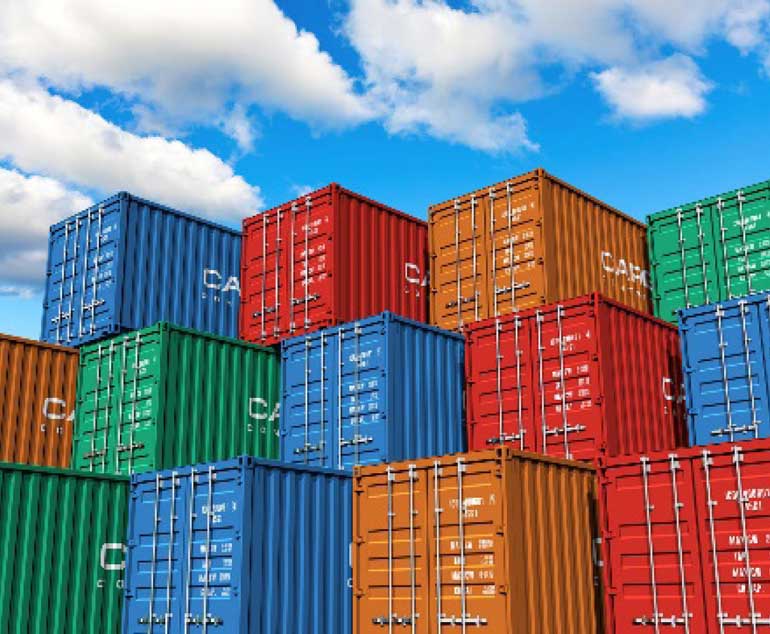Sunday Dec 15, 2024
Sunday Dec 15, 2024
Thursday, 24 September 2015 00:00 - - {{hitsCtrl.values.hits}}
Today is World Maritime Day. A shipping container does not mean much to those who see it as an obstacle to traffic movement on roads. But almost 95% of consumer goods, finished products, refrigerated food or medicines, etc. move around the world in a 20-foot box (or its double), an innovation made in 1956 by Malcom McLean, an American trucking magnate who revolutionised world trade.
The uniform metal containers known as the ‘box’ at first glance may just appear to be humble metal boxes. But containers can be easily moved between lorry, train and ship and have reshaped global trade and logistics over the past few decades, creating millions of dollars of revenue and jobs across the world.
How did containers boost trade?
Before the box was invented goods were shipped as they had been for centuries. Crammed into the hold of a ship, loose cargo in wooden crates would be loaded and unloaded by vast crews of dockworkers. The process was unwieldy, unreliable and so slow that ships often spent longer docked than they did at sea.
The theft of transported goods was rampant; as an old joke put it, dock workers used to earn “$ 20 a day and all the Scotch you could carry home”. All this meant low speed and high cost.
Containers revolutionised the way we move global trade
An article about the container published in the Economist says: “The price of everything fell, starting with the cost of loading and unloading. When Mr. McLean looked at the costs of his first container ship, he found that it cost $ 0.16 per tonne to load compared with $ 5.83 per tonne for loose cargo. Between 1965 and 1970 the amount of capital locked up per tonne of inventory in transit between Hamburg to Sydney fell by half. Because containers were packed and sealed at the factory, losses to theft plummeted, which in turn drastically reduced insurance costs.
“More could also be loaded: in 1965 dock labour could move only 1.7 tonnes per hour onto a cargo ship; five years later they could load 30 tonnes in an hour. As a consequence, ships could get bigger and more efficient while still spending less time in port. As containers made inland distribution by train and lorry easier, ports became bigger and fewer in number. (In 1965 there were 11 loading ports in Europe; by 1970 there were three). This, along with increased productivity, meant fewer dockworkers were needed, undermining their bargaining power and reducing the number of strikes.”
Not bad for a box of 20 feet or its double
In 2006, container shipping celebrated its 50th anniversary as an innovation that had a tremendous impact on the geography of production and distribution. Production became globalised by the better usage of comparative advantages while distribution systems were able to interact more efficiently.
A World Trade Organisation (WTO) paper published in 2013 cleverly disentangles the impact of trade deals from that of containers. It says: “Looking at 22 industrialised countries, it finds that containerisation is associated with a 320% increase in bilateral trade over the first five years and 790% over 20 years. A bilateral free-trade agreement, by contrast, boosts trade by 45% over 20 years, and membership of GATT raises it by 285%. In other words, containers have boosted globalisation more than all trade agreements in the past 50 years put together.”
Today with the scale increases in vessels and terminals, a clear productivity increase in container handling and greater competition, the industry is facing new challenges and opportunities such as expanding markets in Asia and Africa and an imbalance of trade, rapidly fluctuating bunker cost, etc.
The container was an innovation initially utilised in maritime transport but now it has reached new heights as the 20-foot box or its double has made great inroads into global supply chains and the business of logistics over inland freight distribution systems, etc.
The 20-foot box that goes around the world connecting economies and people and increasing the wealth of nations will continue to play a major role in trade development and helping maritime economies of many nations to prosper.
The UN-observed World Maritime Day of the IMO celebrates many aspects of the maritime industry. In 2015 the theme is ‘Maritime education and training’. The maritime industry is a promising area where Sri Lanka can elevate to the next level in economic prosperity if managed professionally.
(The writer is the CEO of the Shippers’ Academy, Colombo, an economics graduate from Connecticut State University USA and the immediate past Secretary General of the Asian Shippers’ Council)
